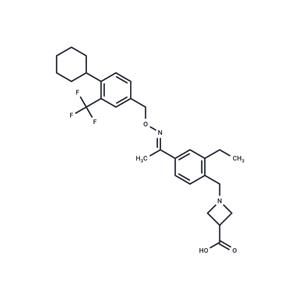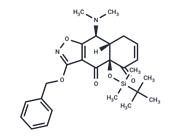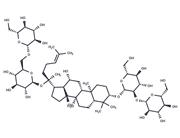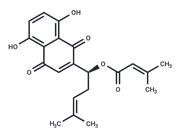| Name | Siponimod |
| Description | BAF312 (Siponimod (BAF-312)), a next-generation S1P receptor modulator, is specific for S1P1 and S1P5 receptors with EC50 of 0.39 nM and 0.98 nM, respectively. The specificity of BAF312 for S1P1 and S1P5 receptors exhibits >1000-fold over S1P2, S1P3 and S1P4 receptors. |
| Cell Research | Agonist-mediated internalization of S1P1 receptors in CHO cells analysed by flow cytometry Myc-tag hS1P1 cells are incubated for 1 h with agonist at 37°C in standard culture medium followed by a PBS wash. An aliquot is kept on ice for 3 h, while another aliquot is left for 3 (or 12) h in culture medium (no agonist) at 37°C. The cells are then incubated either with 4 μg/mL monoclonal mouse anti C-myc IgG1 antibody or with isotype control mouse IgG1 for 60 min at 4°C, followed by an incubation with 1 μg/mL of Alexa488-labelled goat anti-mouse secondary conjugates. The cells are subjected to flow cytometry measurements using 10000 viable cells per sample.(Only for Reference) |
| Kinase Assay | GTPγ[35S] binding assay: The cells are homogenized and centrifuged at 26900 × g for 30 min at 4°C. Membranes are re-suspended in 20 mM HEPES (pH 7.4), 100 mM NaCl, 10 mM MgCl2, 1 mM EDTA and 0.1% fat-free BSA at 2–3 mg protein/mL. GTPγ[35S] binding assay is performed with the membranes (75 mg protein /mL in 50 mM HEPES, 100 mM NaCl, 10 mM MgCl2, 20 μg/mL saponin and 0.1% fat-free BSA (pH 7.4), 5 mg/mL with wheat-germ agglutinin-coated scintillation proximity assay-bead, and 10 μM GDP for 10–15 min. The GTPγ[35S]-binding reaction is started by the addition of 200 pM GTPγ[35S]. After 120 min at room temperature, the plates are centrifuged for 10 min at 300 × g and counted. |
| In vitro | BAF312 is a potent and selective S1P receptor agonist. Its EC50s for S1P1 and S1P5 receptors were 0.39 nM and 0.98 nM, respectively, and it was more than 1000-fold more potent than S1P2, S1P3, and S1P4 receptors at S1P1 and S1P5 receptors. |
| In vivo | BAF312 is a potent and selective S1P receptor agonist. Its EC50s for S1P1 and S1P5 receptors were 0.39 nM and 0.98 nM, respectively, and it was more than 1000-fold more potent than S1P2, S1P3, and S1P4 receptors at S1P1 and S1P5 receptors. |
| Storage | Powder: -20°C for 3 years | In solvent: -80°C for 1 year | Shipping with blue ice/Shipping at ambient temperature. |
| Solubility Information | Ethanol : 41 mg/mL (79.37 mM), Sonication is recommended.
10% DMSO+40% PEG300+5% Tween 80+45% Saline : 1 mg/mL (1.94 mM), Sonication is recommended.
DMSO : 5.17 mg/mL (10.01 mM), Sonication is recommended.
|
| Keywords | Siponimod | S1PReceptor | S1P5 | S1P4 | S1P3 | S1P2 | S1P1 agonist | S1P1 | S1P Receptor | S1P receptor | progressive | neurodegeneration | multiple sclerosis | Lysophospholipid Receptor | lymphocytes | LPLReceptor | LPL Receptor | LPL | Inhibitor | inhibit | inflammation | BAF312 | BAF 312 |
| Inhibitors Related | Fingolimod hydrochloride | SLP9101555 | LX-2931 | Sphingosine-1-phosphate | CYM50374 | ASP-4058 | Ki16198 | Ceranib-2 | Fingolimod | MP-A08 | S1PR1 modulator 1 | Ozanimod |
| Related Compound Libraries | Highly Selective Inhibitor Library | Anti-Neurodegenerative Disease Compound Library | Bioactive Compound Library | Membrane Protein-targeted Compound Library | EMA Approved Drug Library | Anti-Cancer Clinical Compound Library | Drug Repurposing Compound Library | Anti-Cancer Approved Drug Library | Immunology/Inflammation Compound Library | Bioactive Compounds Library Max | GPCR Compound Library | Anti-Cancer Drug Library |

 United States
United States






